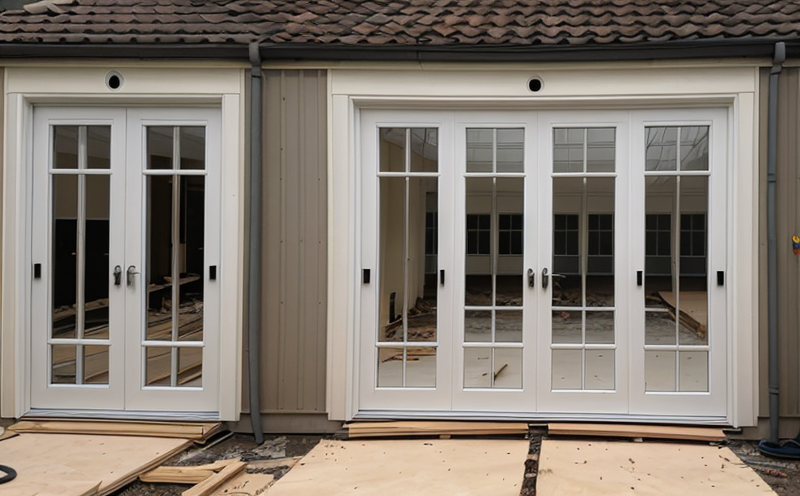Fire Endurance Testing of Timber Windows
In fire safety testing, timber windows are critical components that must withstand extreme temperatures and flames to ensure occupant safety. This test evaluates the performance of timber windows under controlled fire conditions, assessing their ability to retain structural integrity and prevent the spread of fire. The primary goal is to determine how long a window can maintain its insulating properties against heat and smoke while protecting occupants from the hazards of a fire.
The process involves exposing the timber windows to high temperatures and flames in a laboratory-controlled environment that simulates real-world fire scenarios. This testing ensures compliance with international standards such as ISO 15230, which specifies the method for determining the fire resistance of doors, windows, and similar products. By adhering to these standards, manufacturers can ensure their products meet the necessary safety requirements before they are installed in buildings.
During the test, the specimen is placed within a furnace where it undergoes exposure to temperatures exceeding 800°C for an extended period. The duration of the test varies depending on the specific product and its intended use. For instance, windows used in high-risk areas may require longer endurance times. This testing not only evaluates the structural stability but also checks whether the window can prevent the spread of smoke and fire to adjacent areas.
The testing process involves detailed preparation steps that include selecting appropriate specimens, ensuring they are free from defects or damage prior to testing, and applying any necessary coatings or finishes as specified by the standard. The apparatus used in this test includes a furnace capable of reaching high temperatures, thermocouples for monitoring internal temperatures, and specialized software for data acquisition.
The results of fire endurance tests provide critical information on the performance characteristics of timber windows under extreme conditions. These insights are invaluable to quality managers, compliance officers, R&D engineers, and procurement professionals who rely on robust test outcomes to make informed decisions about product design, manufacturing processes, and material selection.
Understanding the importance of this testing is crucial for stakeholders in various sectors including residential construction, commercial buildings, and public infrastructure. By investing in fire endurance testing, organizations can safeguard lives and property by ensuring that their facilities meet stringent safety standards.
Scope and Methodology
| Test Parameters | Standard Compliance | Testing Duration |
|---|---|---|
| Temperature Exposure: 800°C and above | ISO 15230 | Varies by Specimen Type |
| Smoke and Heat Spread Prevention | IEC 62697 | Duration of Exposure |
The fire endurance test for timber windows follows a structured methodology that begins with specimen preparation. Specimens are carefully selected, free from defects or damage, and may be coated or finished according to the specific requirements outlined in relevant standards.
During the testing process, thermocouples placed strategically within the furnace monitor internal temperatures, ensuring accurate data collection throughout the exposure period. The duration of the test varies based on the type and application of the specimen, with higher-risk applications requiring longer exposures.
The results are analyzed using specialized software that processes the collected temperature data to determine compliance with the specified standards. Compliance officers can then use these results to ensure their products meet all necessary safety requirements before market release.
Why Choose This Test
- Ensures compliance with international fire safety standards.
- Provides critical data on smoke and heat spread prevention.
- Supports the design of safer, more resilient buildings.
- Enhances occupant safety in high-risk areas.
- Facilitates informed decision-making for quality managers and R&D engineers.
The fire endurance testing of timber windows is essential for ensuring that these critical components meet stringent safety standards. By incorporating this test into the development process, manufacturers can enhance product reliability and performance, ultimately contributing to safer environments for occupants.
Choosing this test allows organizations to demonstrate their commitment to quality and compliance with regulatory requirements. It also enables stakeholders to make informed decisions based on rigorous testing protocols that have been validated by international standards.
Environmental and Sustainability Contributions
- Reduces the risk of structural damage from fires.
- Promotes the use of fire-resistant materials in construction.
- Minimizes the spread of smoke and heat, enhancing safety.
- Supports sustainable building practices by ensuring product reliability.
The importance of fire endurance testing extends beyond immediate safety concerns. By incorporating this test into their processes, manufacturers contribute to broader sustainability goals. For instance, fire-resistant timber windows can help reduce the environmental impact associated with structural damage caused by fires. Additionally, these products play a role in promoting sustainable building practices by ensuring that construction materials are reliable and effective.
The use of fire-resistant timber windows also aligns with global efforts to enhance public safety and improve quality of life. By preventing the spread of smoke and heat, these windows contribute to healthier indoor environments, which is particularly important for vulnerable populations such as children and elderly individuals.





